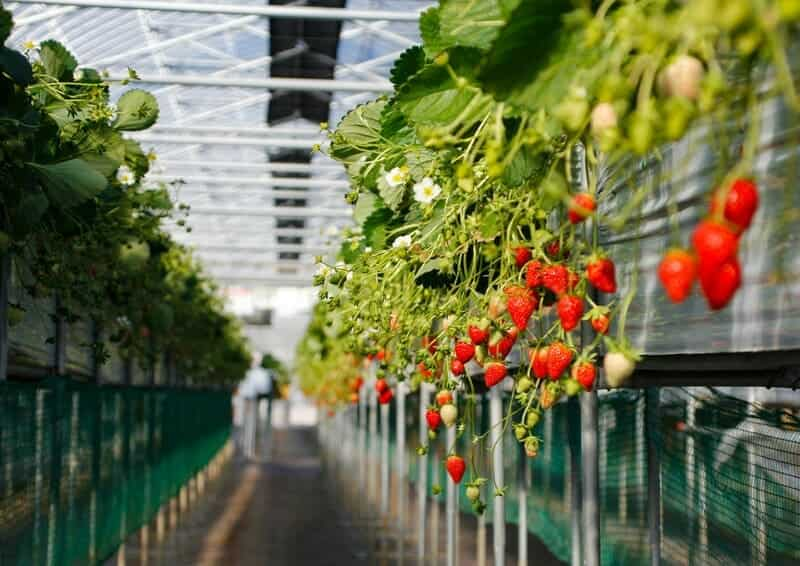The National Institute of Agricultural Technology (INTA) in Argentina is pioneering the integration of renewable energy into intensive strawberry farming. Through the use of wind turbines, farmers can efficiently collect and store water, which is then used for drip irrigation in microtunnels. This approach guarantees high yields, profitability, and an alternative to traditional farming methods. For the past three years, the “Frutillas del Viento” (Wind Strawberries) project has successfully cultivated between 15,000 and 17,000 strawberry plants annually.
The Unique Flavor of “Frutillas del Viento”
Strawberries grown in the Chubut region are known for their exceptional sweetness. To enhance production, researchers and extension specialists from INTA Esquel promote renewable energy solutions to support cultivation in microtunnels with drip irrigation. The use of wind turbines and solar panels allows for efficient water pumping, reducing dependency on conventional energy sources.
Eduardo Miserendino, a professional from INTA Esquel, highlights that “the drip irrigation system ensures efficient and rational water usage, as the required irrigation levels fluctuate daily due to temperature and wind variations.”
This technology optimizes crop yield and profitability, offering a sustainable alternative to traditional agriculture. The INTA team has developed a production system that includes microtunnels, drip irrigation, black mulch soil coverage, and double-row planting on raised beds. This method ensures high-quality fruit production using organic fertilizers. Additionally, renewable energy-powered water pumping systems are integrated into the process.
A Collaborative Effort for Sustainability
The project’s success stems from INTA’s collaboration with the 500RPM Foundation, which specializes in renewable energy. The initiative brings electricity to rural areas and provides practical training in wind energy for farmers. Currently, 23 farmers are participating in the project, with over 50,000 strawberry plants cultivated across several locations, including Alto Río Percy, Cholila, El Hoyo, Paso del Sapo, Costa del Lepá, Paso de Indios, Tecka, and Esquel.
“To integrate renewable energy, we built wind turbines in partnership with technical schools in the province. These turbines convert wind energy into electricity and are used alongside photovoltaic panels in production facilities,” Miserendino explains.
Adapting to Climatic Challenges
The Chubut region experiences significant variations in annual rainfall. In Esquel, precipitation levels range between 500 and 600 mm per year, while areas 100 km to the east receive less than 200 mm. The growing season, from September to May, presents unpredictable weather conditions, including strong winds, frost, and warm days in spring.
Microtunnels help mitigate climatic variability. By adjusting openings and closures, farmers can regulate temperatures and protect crops from wind damage. Since frost can occur throughout the year, constant monitoring is necessary to safeguard the plants.
Efficient Drip Irrigation System
The drip irrigation system consists of tapes with emitters (drippers) spaced every 10 cm, delivering one liter of water per hour. Once the valves are opened, the tapes fill with water, and upon reaching optimal pressure, they begin to drip. Irrigation is scheduled during peak sunlight hours when the plants have the highest water demand, ensuring they do not suffer from excessive heat.
Strawberry planting in Patagonia takes place between September and October, during the coldest months. However, the lengthening daylight hours help raise temperatures inside the microtunnels, stimulating plant growth. Harvesting begins in November and continues until March.
Despite the controlled environment, initial flowers may not be properly pollinated due to a lack of insects or extreme frost damage. Consequently, early fruits, typically used for jam production, may appear misshapen.
The Secret Behind the Sweetness
Patagonian strawberries owe their sweetness to two key factors: long summer days and cool nights. With over 16 hours of daylight, the plants undergo extended periods of photosynthesis, resulting in higher sugar production. At night, respiration rates decrease, leading to greater sugar accumulation. As a result, these strawberries have a sugar content of 10 to 14 degrees Brix, compared to the 7 to 8 degrees Brix of strawberries from other regions.
To maintain this high quality, the “Frutillas del Viento” project tailors fertilization plans based on each farmer’s soil, water, and irrigation characteristics. Organic fertilizers and beneficial microorganisms are employed to promote healthy and productive crops.
Expanding Strawberry Cultivation in Chubut
The northwestern region of Chubut hosts the largest area dedicated to strawberry plant propagation. Approximately six specialized nurseries produce 65 million strawberry plants for Argentina’s primary production zones, such as Coronda and Tucumán. Around 250 hectares between El Maitén and Trevelin are cultivated primarily in open fields with sprinkler irrigation. These nurseries supply plants for winter production on 1,300 hectares in the northern part of the country.
Meanwhile, fruit production is concentrated in El Hoyo and Trevelin, where different levels of technology are applied. In some cases, irrigation is done by furrow without mulch, resulting in lower-quality fruit.
Locally Built Renewable Energy Solutions
Technical school students, with guidance from the 500RPM team, construct wind turbines that supply energy to water pumps. These pumps transport water to elevated reservoirs, allowing it to flow to crops via gravity at optimal pressure and flow rates.
“These wind turbines harness wind energy, which is stored in batteries. If wind speeds become excessive, the turbines have an automatic braking system to prevent damage. Additionally, any excess energy is diverted to a resistor,” Miserendino explains.
The “Frutillas del Viento” project exemplifies how renewable energy can revolutionize agriculture, making it more efficient, sustainable, and profitable. By harnessing wind and solar power, farmers in Chubut can produce high-quality strawberries while reducing their environmental impact. This initiative not only benefits local growers but also serves as a model for integrating clean energy into agriculture worldwide.

